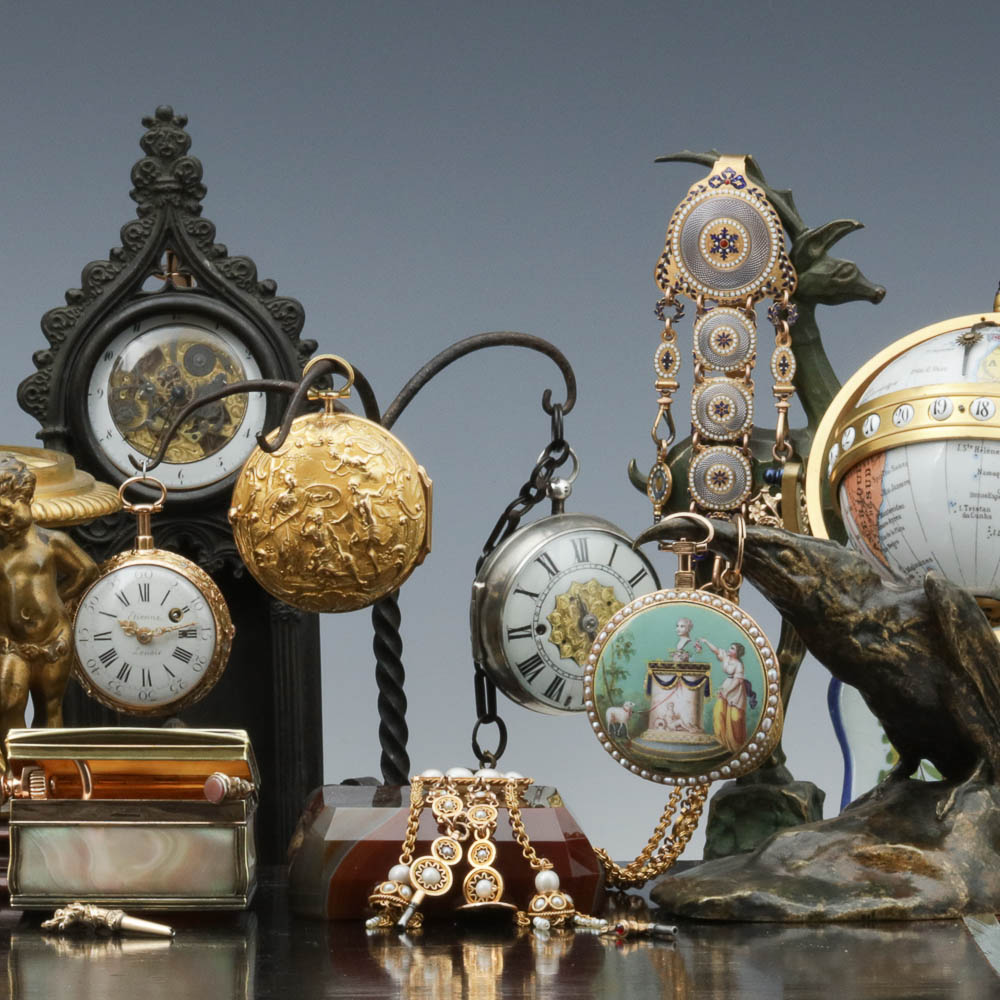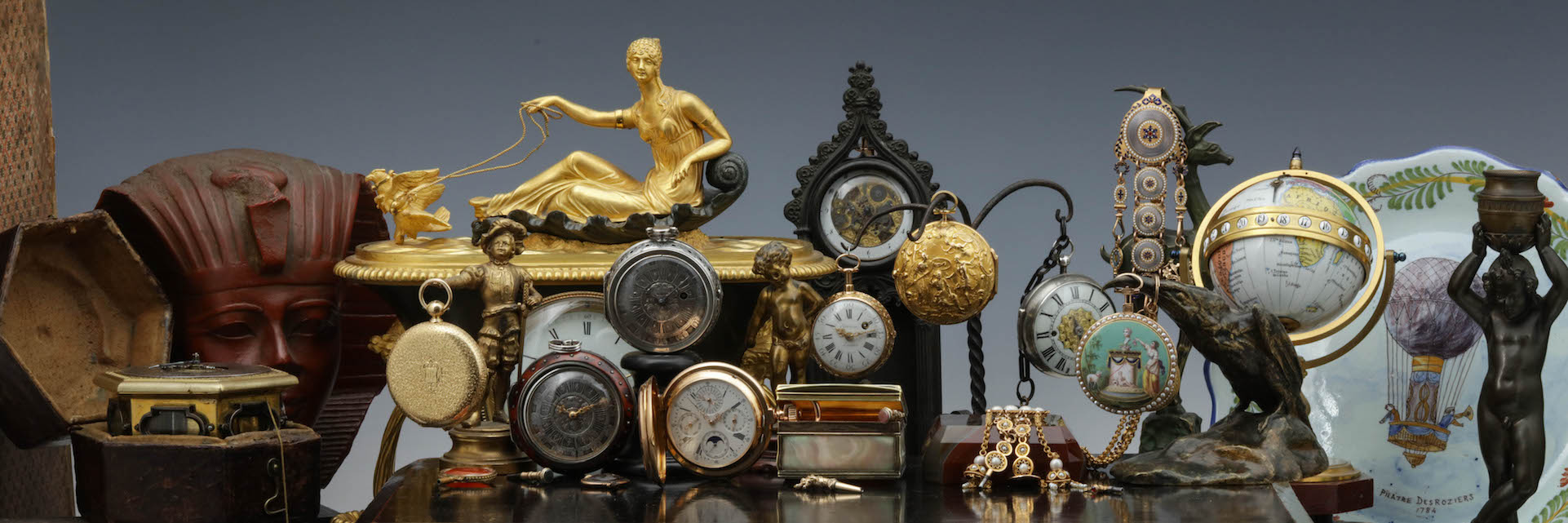.jpg)
.jpg)
.jpg)
.jpg)
.jpg)
.jpg)
.jpg)
.jpg)
.jpg)
.jpg)
.jpg)
.jpg)
.jpg)
.jpg)
.jpg)
.jpg)
.jpg)
.jpg)
.jpg)
.jpg)
.jpg)
A. BROCOT et DELETTREZ, à Paris Astronomische Tischuhr mit Ewigem Kalender, Mondphase und Zentralsekunde ca. 1880.
Zifferblatt: Das obere weiße Emaille Zifferblatt mit versenktem Zentrum und sichtbarer Brocot-Hemmung, die Lünette aus vergoldeter Bronze, radiale römischen Ziffer für die Stunden, große Sekunden Spur mit arabischer Fünf-Minuten-Einteilung, filigraner zentraler Sekundenzeiger aus Stahl und gebläuten Breguet-Stahlzeigern.
Darunter befindet sich das Zifferblatt des Ewigen Kalenders aus fein bemalter Emaille mit Öffnung für die Mondphase, die von einem feinen, farbig emaillierten Nachthimmel umrahmt wird. Links und rechts die Allegorien des Tages und der Nacht, jeweils dargestellt als Frau, die eine Lampe in ihren Armen hält - ebenfalls in feinen Nuancen gemalt. Unterhalb drei Hilfszifferblätter für die Anzeige von Wochentag, Datum, Monat und Schaltjahr, samt Jahreszeiten auf Französisch; die Zeiger sind aus Stahl, einschließlich des mittig angebrachten Monatszeigers, der eine gegossene Sonne trägt. Die Zifferblätter werden von einem kunstvoll vergoldeten und floral gravierten Fond umrahmt. Beide Zifferblätter sind perfekt erhalten, alle Zeiger sind original.
Uhrwerk: Das achttägige Uhrwerk mit Brocott - Ankerhemmung, Kompensationspendel mit Brocot-Feder-Aufhängung die über eine Vorrichtung über der „12“ mit einem Schlüssel justiert werden kann. Das Halbstunden-Schlagwerk (mit einem Hammer, der eine große Glocke anschlägt) hat einen sehr schönen Klang.
Das Werk ist vom Verkäufer signiert mit "Per Bally Brevette Paris No. A 1995 und A 2005" und der Brocott Werks-Nr. „4200“. Das bimetallische Rost-Pendel ist eine Variante des Pendels von Ellicott und wurde 1847 von Brocot patentiert. Das runde Werk mit dem Ewigen Kalender wird über einen Hebel aus dem Uhrwerk gesteuert. Beide Werke sind in einem sehr schönen, voll funktionsfähigem Zustand sowie vom Uhrmacher gereinigt und auf Funktion überprüft.
Gehäuse: Der Bronzerahmen mit profiliertem weißen Sockel aus Carrara – Marmorsockel, ebenso der Giebel. Alle Seiten des Gehäuses sind verglast (Facettschliff), eine Tür jeweils vorn und hinten. Das Gehäuse ist in sehr schönem Zustand. Diese Uhr gehört zu den größten und kompliziertesten Kalenderuhren von Brocot.
Vergl. Deutsches Uhrenmuseum Furtwangen, ein fast Identische Uhr, Signiert Jean-Antoine Lépine. Die Firma Le Roy in Paris bezog einige Astronomischen Tisch-Uhren von Brocot und verkaufte Sie unter eigenen Namen.
H.B.T. 47cm. 30cm 22cm Gewicht 18,5Kg.
Louis-Achille Brocot (1817-1878) war sowohl Uhrmacher als auch Mathematiker. Er war wahrscheinlich der erfinderischste der fünf Brüder, die der Uhrmacher Louis-Gabriel Brocot gezeugt hatte. Er hielt zahlreiche Patente und erfand und verbesserte zahlreiche Aspekte der Uhrmacherei, vor allem durch die von ihm entwickelte und benannte Hemmung. Außerdem hat er 1855 eine Reguliervorrichtung für die Pendelfeder erfunden 1851 wurde Jean-Baptiste Delettrez sein Geschäftspartner.
Bei der Weltausstellung 1857 gewann die Firma eine Medaille Erste Klasse für eine Pendule mit Kalender und Mondphase. Nach dem Tod von Brocot 1878 arbeitete Delettrez alleine weiter. Die Uhren wurden dann mit „JBD“, signiert, wie auf dem vorliegenden Pendel sichtbar. Jean-Baptiste Delettrez verstarb am 25. Mai 1887 in Paris und wurde auf dem Friedhof von Montparnasse beigesetzt.
Jean-Baptiste "Antoine" Delettrez wurde am 1. Mai 1816 in Paris 5e Arrondissement geboren. Er war der Sohn von Jean-Baptiste Joseph Delettrez und Zoé Divry.
Philibert Antoine Bally war ein Pariser Uhrenhändler und eventuell auch Uhrmacher. 1848 war Philibert A. Bally in der Rue Notre-Dame-de-Nazareth 25 ansässig. Bally erhielt zu ein Patent für ein Hemmung, am 25. April 1864 wurde ein großer Katalog veröffentlicht "Catalogue des modèles et surmoulés... de la maison Philibert Bally
A. BROCOT et DELETTREZ, à Paris Astronomical table clock with perpetual calendar, moon phase and central second hand ca. 1880
Dial: The upper white enamel dial with recessed center and visible Brocot escapement, gilt bronze bezel, radial Roman numeral for the hours, large seconds track with Arabic five-minute graduation, filigree steel central seconds hand and blued steel Breguet hands.
Below is the perpetual calendar dial in finely painted enamel with aperture for the moon phase, framed by a fine colored enameled night sky. On the left and right, the allegories of day and night, each depicted as a woman holding a lamp in her arms - also painted in fine nuances. Below, three subdials to indicate the day of the week, date, month and leap year, complete with seasons in French; the hands are steel, including the centered month hand bearing a cast sun. The dials are framed by an ornate gilt and floral engraved background. Both dials are perfectly preserved, all hands are original.
Movement: The eight-day movement with Brocott - lever escapement, compensation pendulum with Brocott spring suspension device which can be adjusted above the "12" with a key. The half hour striking movement (with a hammer striking a large bell) has a very nice sound.
The movement is signed by the reseller with "Per Bally Brevette Paris No. A 1995 and A 2005" and the Brocott movement no. "4200". The bimetallic grate pendulum is a variant of Ellicott's pendulum and was patented by Brocott in 1847. The circular movement with the perpetual calendar is controlled by a lever from the movement. Both movements are in a very nice, fully functional condition as well as cleaned and checked for function by the watchmaker.
Case: The bronze frame with profiled white base made of Carrara - marble base, as well as the pediment. All sides of the case are glazed (facet cut), one door each front and back. The case is in very nice condition. This clock is one of the largest and most complicated calendar clocks by Brocot.
See German Clock Museum Furtwangen, an almost identical clock, signed Jean-Antoine Lépine. The company Le Roy in Paris bought some astronomical table clocks from Brocot and sold them under their own name.
H.W.D. 47cm. 30cm 22cm Weight 18,5Kg.
Louis-Achille Brocot (1817-1878) was both a watchmaker and a mathematician. He was probably the most inventive of the five brothers fathered by watchmaker Louis-Gabriel Brocot. He held numerous patents and invented and improved many aspects of watchmaking, most notably through the escapement he developed and named. He also invented a regulating device for the pendulum spring in 1855 In 1851 Jean-Baptiste Delettrez became his business partner. At the 1857 World's Fair, the company won a First Class medal for a pendulum with calendar and moon phase. After Brocot's death in 1878, Delettrez continued to work alone. The clocks were then signed "JBD", as visible on the present pendulum. Jean-Baptiste Delettrez died in Paris on May 25, 1887, and was buried in Montparnasse Cemetery.
Jean-Baptiste "Antoine" Delettrez was born on May 1, 1816 in Paris 5e Arrondissement. He was the son of Jean-Baptiste Joseph Delettrez and Zoé Divry.
Philibert Antoine Bally was a Parisian watch dealer and possibly watchmaker. In 1848, Philibert A. Bally was located at 25 rue Notre-Dame-de-Nazareth. Bally was granted a patent for an escapement, on April 25, 1864 a large catalog was published "Catalogue des modèles et surmoulés... de la maison Philibert Bally...
| Hersteller: | A. BROCOT et DELETTREZ, à Paris |
| Material: | Bronze, MARMOR |
| Größe: | H.B.T. 47cm. 30cm 22cm |
| Gewicht: | 18,5 Kg |
| Uhrwerk: | Anker Hemmung |
| Zifferblatt: | emaille / Enamel |
| Funktionen: | EWIGER KALENDER; MONDPHASE |
| Alter: | CA: 1880 |
| Zustand: | excellent Condition |
| Land: | Frankreich / France |
Die Liebe zu alten Dingen lässt mich seit über fünfzwanzig Jahren als Antiquitätenhändler tätig sein. Ursprünglich in Dänemark zur Welt gekommen, habe ich seit langem in Berlin meinen Lebensmittelpunkt gefunden. Neugier und das Bestreben, mein Fachwissen zu erweitern, führen zum regen Austausch mit Sammlern. Nicht zuletzt durch diese Kontakte kaufe ich ständig Nachlässe und Sammlungen und bekomme so immer wieder schöne alte Sachen. Stets auf der Suche nach kleinen und großen Kostbarkeiten, bedeuten mir dabei die Qualität und die hohe Handwerkskunst der einzelnen Stücke sehr viel. Seit über 18 Jahren konzentriere ich mich auf den Handel bei ebay. Dabei liegt mir ein schneller, kundenfreundlicher und unkomplizierter Ablauf besonders am Herzen.
Ich wünsche ihnen viel Freude beim Stöbern, sollte Sie Fragen haben, zögern Sie nicht mich zu kontaktieren,
carsten berger
The love for old things has kept me working as an antique dealer for over twenty-five years. Originally born in Denmark, I have been living in Berlin for a long time. Curiosity and the desire to expand my specialist knowledge lead to a lively exchange with collectors. Not least through these contacts I constantly buy estates and collections and get beautiful old things again and again. Always on the search for small and large treasures, the quality and the high craftsmanship of the individual pieces mean a lot to me. For over 18 years I have been concentrating on trading on ebay. A fast, customer-friendly and uncomplicated process is particularly important to me.
I wish you a lot of fun while browsing, should you have any questions, do not hesitate to contact me.
carsten berger

